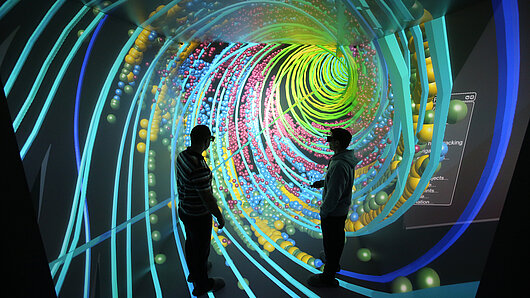High-Performance Computing Center Stuttgart

Located inside the HLRS Visualization Lab, the CAVE offers powerful tools for visualizing and interacting with large, complex data sets. Wearing 3D glasses, users of the CAVE enter a cube where they become enveloped inside an immersive, virtual reality environment. Multiple people can enter the CAVE at the same time, enabling colleagues to discuss and interact with data collaboratively.
The floor of the CAVE is made of a three-layer laminated safety glass covered by a rear projection screen, while the walls and ceiling are built of dark plexiglass screens. The projection system is also networked with powerful supercomputers located elsewhere in the HLRS facility, making it possible to integrate visualization with simulation using high-performance computers.
Once inside the virtual reality environment users can easily zoom in and out using a hand-held wand, making it possible to closely observe features contained within the datasets at multiple scales. It is also possible to change and update data parameters in real time, enabling rapid investigation of the effects of those changes and the optimization of digital models.
In 2020, the physical CAVE facility was enhanced by the development of software that makes it possible for colleagues in remote locations to experience the same visualization being displayed at HLRS through the use of 3D head-mounted displays connected over the Internet.
At HLRS, the CAVE is used for data visualization in many fields, including computational fluid dynamics, structural mechanics (e.g., crash analysis), architecture, engineering, city planning, atmospheric modeling, and for the media arts.
HLRS's Visualization Department is engaged in many projects and collaborations focused on developing new applications of virtual and augmented reality.
| Dimensions | 2.7 m x 2.7 m x 2.7 m |
| Image projection | Barco F80-Q7 single chip active stereo DLP projectors (5) |
| Image resolution | 2560 x 1600 pixels |
| User interface | ART Trackpack Optical Tracking System |
| System | DALCO Visualization Cluster |
| Number of nodes | 34 |
| CPU processors | Intel Xeon CPU E5-2643 0, 3.3 GHz (11) Intel Xeon Gold 6134 CPU, 3.2 GHz (11) Intel Xeon CPU E5-2670 0, 2.6 GHz (12) |
| GPU processors | NVIDIA Quadro P6000 (11) NVIDIA Quadro K6000 (11) |
| Memory | 256 GB RAM (head nodes) 128 GB (rendering nodes) |
| Networking | QDR Infiniband interconnect |